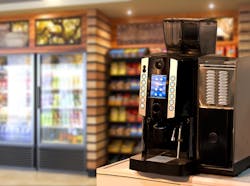In 2014, nearly one in four vending operators added micro markets, according to Automatic Merchandiser. Most operators witness higher sales in micro markets due to more fresh food options and better profit margins. But operators are also finding higher micro market sales in a surprising area: coffee service.
Willingness to pay
It’s no secret that consumers are fancying a higher-quality cup of coffee these days. Operators are using this fact to provide a more expensive OCS offering in micro markets, because customers are more willing to pay for a better cup of coffee. Not only do some operators charge more, but they use a ‘premium’ blend of coffee and market it as such, too.
But it doesn’t just stop with a good tasting cup of coffee. Consumers are willing to pay for convenience, as well. In one case, an operator found that employees in a high rise office building were traveling to the micro market in order to purchase coffee from a branded machine, even though that same company had a shop on the first floor. “It was convenient and the employees could be in control of how long it took,” he said. Operators who can’t offer a premium cup of coffee in a micro market run the risk of consumers leaving the building for a hot drink, which could mean lost food sales, too.
Single cup awareness
Single cup is the biggest-selling factor in micro markets, which isn’t surprising. In the National Coffee Association Single Cup Format 2014 report, they found that 74 percent of consumers had a positive perception of single cup because it allowed them to experiment with different brands of coffee. Single cup brewers are also the second most common preparation option with consumers, and that has helped with single cup placement in micro markets. Several operators have reported having positive reception selling single cup in micro markets.
More options
Operators are reporting that bean-to-cup machines are on the rise in micro markets as well. A West Coast operator said, “Bean-to-cup machines have increased in popularity quite considerably, and quite frankly, the profit margins are better.” Automatic Merchandiser reported in the 2014 State of the Coffee Service Industry that nearly 15 percent of operators placed a bean-to-cup machine in a micro market location last year.
But options don’t end with single serve and bean-to-cup machines. It’s important for operators to evaluate each location separately to determine which OCS method will result in the best profit. A Southeast operator said that his customers preferred a coffee vending machine in their micro market. “In one location, they didn’t want to make the single cup themselves, so we put in a coffee vending machine with a higher-end coffee,” he said. That method has been successful for him.
Offering coffee in micro markets comes down to one must-have: a good tasting, satisfying cup of coffee for consumers. Operators can get the most out of their entry into the micro market segment by focusing on and catering to each location’s OCS needs.
